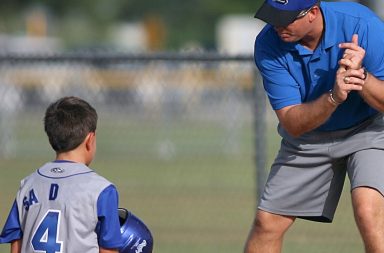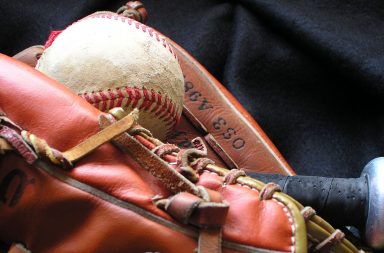If you’ve ever been to a little league practice before, chances are that you’ve seen a variation on the following: the coach lines his players up, hits the ball to them, and the ones with some existing skill or innate talent do a good job… while the new player or the less talented athelete struggles. The coach tells them to “get in front of the ball,” to “get their glove down,” and to “keep the ball in front of them.” And that’s about the extent of it.
Maybe this improves over the course of the season. Unfortunately, it has been my experience that this is all too often not the case – instead, the lesser fielders get dropped into the outfield in an effort to minimize their liability to the team. As a result, they get less practice reps than the infieldiers, and if anything, the disparity between the skill level of infield and outfield widens further.
Now, I’m not suggesting that you should place your weakest fielder at shortstop. What I am suggesting is that you, as the coach, need to make sure that you give all of your players the tools they need in order to succeed. The best way you can do this is by emphasizing – and then consistently teaching – the fundamentals of baseball fielding.
Remember the triangle. Before you begin fielding, line your players up with some space in between them. Have them set up with their feet about shoulder width apart. Now, have them reach their glove out on the ground in front of themselves about the same distance as the width betwen their feet, as if they are fielding an imaginary grounder. Have them hold the position, and point out that the three things on the ground – each foot, plus the glove – form the points of a triangle. This is the ideal position for fielding a ground ball; feet too close together take away the ability to move laterally, a glove too close to the feet gives no room for error when scooping up a grounder.
Use both hands. This is possibly the most critical aspect of fielding grounders that you can teach, and is oddly enough, the one most often ignored by coaches. When set to field a grounder, the glove should be placed on the ground, and the other hand should be open, above the glove, with the heels of the hand fairly close together (the analogy used for younger players is that of an alligator’s mouth).
When the ball enters the glove, the secondary hand should automatically close over the ball and gather it in; not only does this ensure that the ball won’t pop out, but it places the fielder into a favorable position to make a throw. The further, and less obvious benefit, is that balls that skip off of the heel of the glove cannot pop up and hit the fielder in the face if this basic fundamental is employed; the top hand will simply deflect the ball back down into the dirt where it can then be recovered.
Start low, then come up high. Teach your kids that, when fielding a grounder, they should always begin with their glove all the way on the ground. If the ball takes a hop, they can bring their glove up to it; even if they misjudge, odds are excellent that their top hand and/or their body will block the ball and keep it from going past.
However, if the player tries to start with their glove high and then go down to the ball, they will invariably let grounder after grounder go between their legs.
Keep soft hands. Ground balls come in with so much velocity that they will frequently bounce out of even a perfectly placed glove. Bringing the second hand in will help this, but sometimes, the ball will still pop out in the time it takes to bring that hand down.
The best way to reduce this effect is by having soft hands. In other words, teach your players to not lock their elbows in, thus presenting a brick wall for the baseball to richochet off of. Instead, they should “give” ever so slightly – this will reduce the energy of the baseball enough to prevent it from popping out. If you have a player who always seems to get into the right position for fielding, who uses two hands, who gets his glove down, and yet still seems to lose a lot of balls, odds are excellent that he has no idea what soft hands are.
Watch that footwork! The first instinct that many young fielders have when fielding a grounder not right right at them is to turn to the side and run towards the ball. Unless the fielder is trying to make a stab at a ball deep in the hole (and even then they should give ground, taking a proper angle), this is the wrong way to do it.
If the player turns his head and runs, he loses track of the ball. Since the first rule of pretty much every phase of baseball is some variation of “keep your eye on the ball,” we know that this cannot be correct! Furthermore, even if the fielder can pick up the ball in time, he themn must turn his body and reset his feet in an effort to get back to a good “triangle” stance.
Coaches are often tempted to ignore fundamentals in the case of a talented fielder who can make plays, even when doing it the wrong way. The fact of the matter is that you are doing a disservice to your player if you take this path.
Instead of turning and running, players should “slide step” to the side, allowing them to keep the eye on the ball. Further, this allows for a simple stop in motion to place the fielder into proper triangle form. Practice this by lining your players up with several feet in between them, and have them simply “slide” to the left, then to the right. Repeat this for a minute or so, until you have them breathing nice and hard.
The idea is that the should be stepping wide to the side, then following the other foot over until their heels almost click together. In younger players, this will be somewhat of a hopping motion, but as they become more accustomed, it should become second nature and more of a glide.
You don’t have to practice footwork every time you meet, but you should emphasize it and correct bad footwork whenever you see it.
Your job as a youth baseball coach is to teach your players, to give them the tools they need to improve. If your players are not improving, ask yourself if you are doing everything you can to help them succeed. If you are not teaching fundamentals – and thus, giving your players instruction on the correct way to play the game – then you are doing them a disservice.


